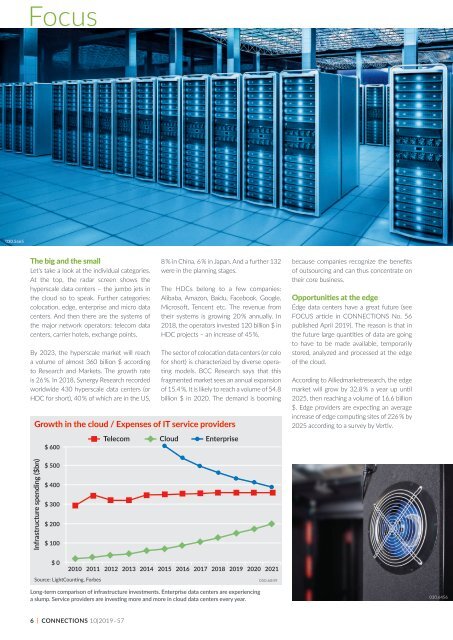CONNECTIONS_57_e
Specialist magazine CONNECTIONS no. 57
Specialist magazine CONNECTIONS no. 57
Create successful ePaper yourself
Turn your PDF publications into a flip-book with our unique Google optimized e-Paper software.
Focus<br />
030.5665<br />
The big and the small<br />
Let’s take a look at the individual categories.<br />
At the top, the radar screen shows the<br />
hyperscale data centers – the jumbo jets in<br />
the cloud so to speak. Further categories:<br />
colocation, edge, enterprise and micro data<br />
centers. And then there are the systems of<br />
the major network operators: telecom data<br />
centers, carrier hotels, exchange points.<br />
By 2023, the hyperscale market will reach<br />
a volume of almost 360 billion $ according<br />
to Research and Markets. The growth rate<br />
is 26 %. In 2018, Synergy Research recorded<br />
worldwide 430 hyperscale data centers (or<br />
HDC for short), 40 % of which are in the US,<br />
$ 600<br />
Telecom<br />
8 % in China, 6 % in Japan. And a further 132<br />
were in the planning stages.<br />
The HDCs belong to a few companies:<br />
Alibaba, Amazon, Baidu, Facebook, Google,<br />
Microsoft, Tencent etc. The revenue from<br />
their systems is growing 20 % annually. In<br />
2018, the operators invested 120 billion $ in<br />
HDC projects – an increase of 45 %.<br />
The sector of colocation data centers (or colo<br />
for short) is characterized by diverse operating<br />
models. BCC Research says that this<br />
fragmented market sees an annual expansion<br />
of 15.4 %. It is likely to reach a volume of 54.8<br />
billion $ in 2020. The demand is booming<br />
Growth in the cloud / Expenses of IT service providers<br />
Cloud<br />
Enterprise<br />
because companies recognize the benefits<br />
of outsourcing and can thus concentrate on<br />
their core business.<br />
Opportunities at the edge<br />
Edge data centers have a great future (see<br />
FOCUS article in <strong>CONNECTIONS</strong> No. 56<br />
published April 2019). The reason is that in<br />
the future large quantities of data are going<br />
to have to be made available, temporarily<br />
stored, analyzed and processed at the edge<br />
of the cloud.<br />
According to Alliedmarketresearch, the edge<br />
market will grow by 32.8 % a year up until<br />
2025, then reaching a volume of 16.6 billion<br />
$. Edge providers are expecting an average<br />
increase of edge computing sites of 226 % by<br />
2025 according to a survey by Vertiv.<br />
Infrastructure spending ($bn)<br />
$ 500<br />
$ 400<br />
$ 300<br />
$ 200<br />
$ 100<br />
$ 0<br />
2010 2011 2012 2013 2014 2015 2016 2017 2018 2019 2020 2021<br />
Source: LightCounting, Forbes<br />
050.6849<br />
Long-term comparison of infrastructure investments. Enterprise data centers are experiencing<br />
a slump. Service providers are investing more and more in cloud data centers every year.<br />
030.6456<br />
6 | <strong>CONNECTIONS</strong> 10|2019–<strong>57</strong>

















